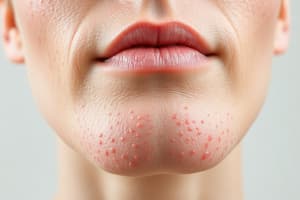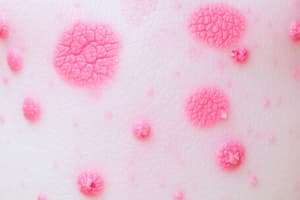Podcast
Questions and Answers
What type of hypersensitivity reaction is primarily involved in acute eczematous dermatitis?
What type of hypersensitivity reaction is primarily involved in acute eczematous dermatitis?
- Type 4 hypersensitivity reaction (correct)
- Type 3 hypersensitivity reaction
- Type 2 hypersensitivity reaction
- Type 1 hypersensitivity reaction
Which of the following is a characteristic clinical feature of acute eczematous dermatitis?
Which of the following is a characteristic clinical feature of acute eczematous dermatitis?
- Blisters and crust formation (correct)
- Acne pustules
- Excessive oiliness of the skin
- Atypical moles
In which areas of the body is atopic dermatitis more commonly observed?
In which areas of the body is atopic dermatitis more commonly observed?
- Areas of flexion such as the cubital and popliteal fossae (correct)
- Back and abdomen
- Face and scalp
- Hands and feet
What is a major contributing factor to photoeczematous dermatitis?
What is a major contributing factor to photoeczematous dermatitis?
What is commonly used for the management of acute eczematous dermatitis?
What is commonly used for the management of acute eczematous dermatitis?
What is the primary underlying pathology of urticaria?
What is the primary underlying pathology of urticaria?
Which mechanism is responsible for the microvascular changes seen in urticaria?
Which mechanism is responsible for the microvascular changes seen in urticaria?
What are the clinical features of urticaria?
What are the clinical features of urticaria?
Which of the following best describes the wheals seen in urticaria?
Which of the following best describes the wheals seen in urticaria?
What is the cause of the raised plaques seen in urticaria?
What is the cause of the raised plaques seen in urticaria?
What is a key pathological feature of Erythema Multiforme?
What is a key pathological feature of Erythema Multiforme?
What clinical manifestation is commonly seen in Erythema Multiforme?
What clinical manifestation is commonly seen in Erythema Multiforme?
Which of the following complications is associated with Erythema Multiforme?
Which of the following complications is associated with Erythema Multiforme?
What is the typical immune response mechanism involved in Erythema Multiforme?
What is the typical immune response mechanism involved in Erythema Multiforme?
What is a typical systemic symptom associated with Erythema Multiforme?
What is a typical systemic symptom associated with Erythema Multiforme?
Flashcards are hidden until you start studying
Study Notes
Acute Eczematous Dermatitis
- Type 4 hypersensitivity reaction: T-cell mediated, meaning the immune system's T cells are involved.
- Causes:
- Allergic contact dermatitis: Antigen (allergen) is presented to naïve CD4 T cells by Langerhans cells (DCs), leading to sensitization and effector/memory T cell formation; re-exposure triggers cytokine release from memory T cells.
- Drug-related: Some medications can trigger this type of dermatitis.
- Photoeczematous: Reaction to light and certain plant chemicals.
- Primary irritant: Caused by loss of function in the filaggrin protein, leading to a type 4 hypersensitivity response.
Atopic Dermatitis
- More severe and common in darker skin tones.
- Typically located in areas of flexion: Such as the cubital fossa (elbow) and popliteal fossa (behind the knee).
Histopathology
- Spongiosis: Fluid accumulation in the epidermis, giving it a spongy appearance.
Complications
- Pruritus: Intense itching.
- Blisters: Can form and eventually crust over.
Clinical Features
- Redness (erythema).
- Dry skin.
- Itching.
- Scaly skin.
Management
- Corticosteroids: Used to reduce inflammation and itching.
Types of Eczema
- Atopic eczema: A chronic, inflammatory skin condition.
- Contact eczema: Triggered by an allergic reaction to a specific substance.
Urticaria (Hives)
- Chronic autoimmune disorder with a type 1 hypersensitivity reaction
- IGE mediated mast cell degranulation causes microvascular hyperpermeability
- Characterized by raised, itchy (pruritic), red plaques called wheals
Urticaria (Hives)
- An autoimmune disorder
- A type 1 hypersensitivity reaction
- Mediated by IgE and mast cells
- Leads to microvascular hyperpermeability
- Characterized by raised, itchy, red plaques called wheals
Erythema Multiforme Pathophysiology
- Characterized by hypersensitivity reaction, often triggered by medications or infections like herpes simplex virus (HSV)
- Immune response involves IgM deposition and inflammatory cell infiltration at the dermis-epidermis junction (interface dermatitis)
- Individual keratinocytes undergo apoptosis, leading to basal keratinocyte degeneration
- Spongiosis, a characteristic of this condition, involves intercellular edema within the epidermis
- Notably, necrosis is absent in typical Erythema Multiforme cases, but may occur in complications
Clinical Features
- Distinctive target or iris-like lesions are a hallmark of Erythema Multiforme
- Positive Nikolsky sign, where the epidermis detaches with minimal pressure, indicates a complication
Complications
- Stevens-Johnson Syndrome: Severe, potentially life-threatening complication involving extensive skin blistering and ulceration
- Toxic Epidermal Necrolysis (TEN): Extreme form with widespread epidermal detachment and high mortality rates
- Widespread Skin Ulceration: Characterized by extensive open sores on the skin
- Epidermal Necrolysis: Necrosis of the epidermis, often leading to shedding of the skin
- Fever-Like Symptoms: Common in Erythema Multiforme, characteristic of a type 4 hypersensitivity reaction
Studying That Suits You
Use AI to generate personalized quizzes and flashcards to suit your learning preferences.




